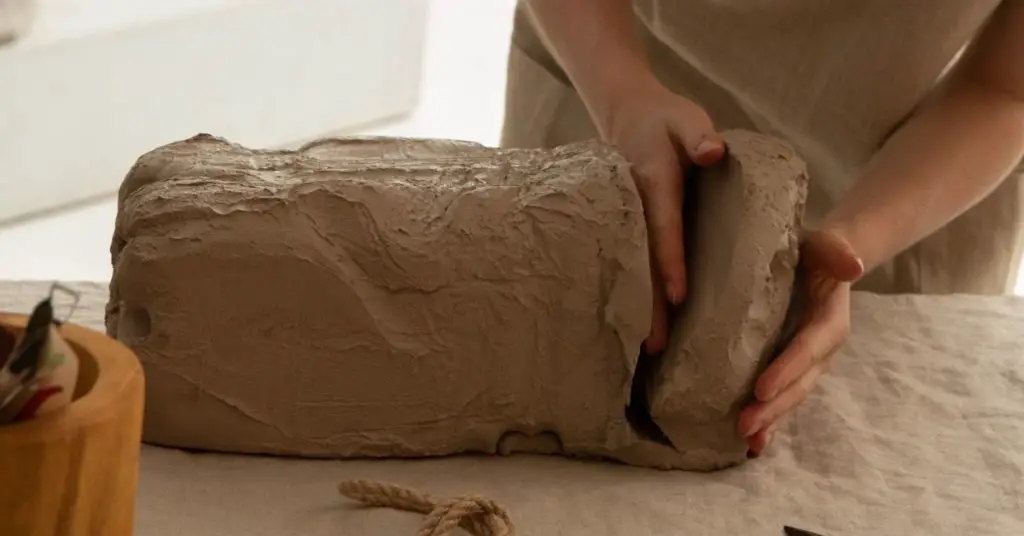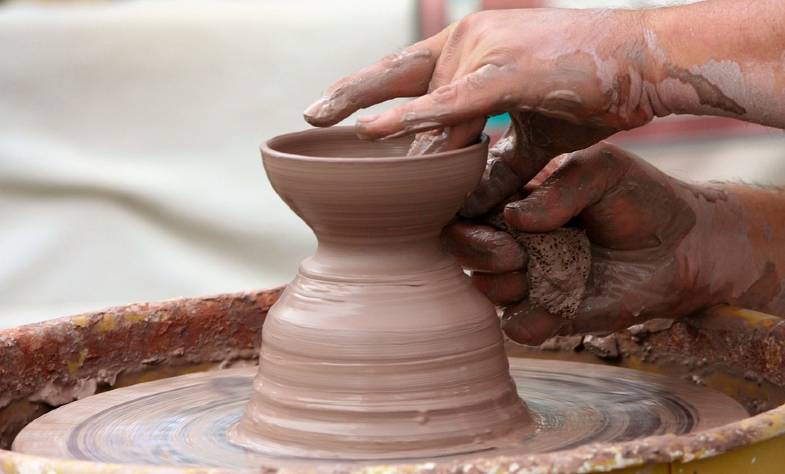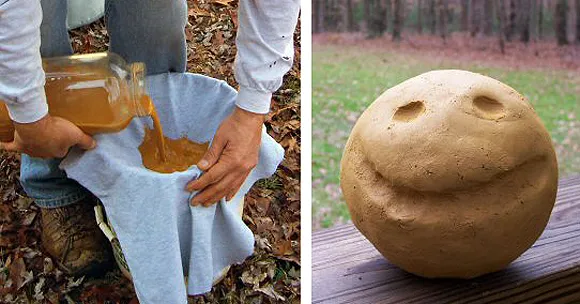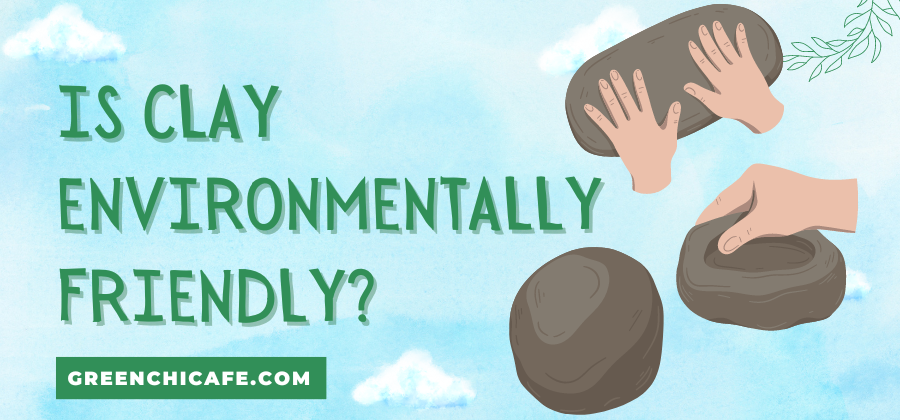Last Updated on June 3, 2024 by Annie Baldwin
In today’s eco-conscious world, we’re all looking for ways to live a bit greener.
Clay, that versatile stuff you probably remember from pottery class, has quietly emerged as a contender for being environmentally friendly.
So, let’s get our hands a little dirty as we explore whether clay can truly play a part in our eco-friendly journey.
Is Clay Environmentally Friendly?

Clay is generally considered an environmentally friendly and sustainable material.
As a natural product of the earth, clay is renewable, reusable, and biodegradable.
Clay has a lower carbon footprint than many materials and provides energy efficiency benefits.
While production does have some environmental impact, clay is one of the more eco-conscious choices for pottery, construction, and design.
Key Points
- Clay is a natural and renewable material that comes from the earth.
- Clay can be reused, recycled, and is biodegradable.
- Clay has a relatively low carbon footprint compared to industrial materials.
Our Opinion
In our opinion, clay is one of the more sustainable materials available.
As experts in the field, we believe clay has many environmental benefits compared to man-made options.
With responsible sourcing and manufacturing, clay can be an excellent eco-friendly choice for crafts, building materials, and other applications.
We feel good recommending clay as an environmentally conscious material.
Is Clay a Sustainable Material?

When it comes to sustainable materials, clay is a top contender. This natural substance found in the earth has many eco-friendly properties:
- Clay is completely natural and obtained responsibly from the earth.
- It can be easily recycled and reused in other projects.
- Clay is durable and long-lasting when fired, so products made from it don’t need frequent replacement.
- It provides good insulation, making clay buildings more energy efficient.
- Clay is breathable and regulates humidity well, creating a healthy indoor environment.
Overall, clay’s natural origins, recyclability, and energy-efficient properties make it a sustainable and environmentally friendly material. When sourced and used responsibly, clay is a great option for pottery, construction, flooring, ceramics like mugs, and more. Its eco-friendly qualities and aesthetic appeal offer many advantages over less sustainable materials.
What Are the Different Types of Clay?

There are many varieties of clay, each with unique properties that lend themselves to certain uses. Some of the main types include:
- Kaolin – This very pure white clay is ideal for porcelain and fine china production.
- Ball clay – Adds plasticity and strength when mixed with other clays. Used for pottery and ceramics.
- Fire clay – Resists high temperatures so is good for pottery meant for cooking and kilns.
- Bentonite – Absorbs water easily, making it good for lining ponds and as a natural sealant.
- Common clay – Lower purity clay used for bricks, cement, and plaster production.
The different physical and chemical properties of these clays determine their best uses. Professional potters and ceramicists blend various types to achieve the characteristics they want in the finished piece.
Understanding the variety of clays available allows artisans to select the optimal material for their creations. With experimentation and experience, clay artists learn which combinations suit their unique vision and style.
How Is Clay Extracted and Processed?

Clay deposits are found in many countries around the world. Surface mining techniques are often used to access seams of clay underground. The clay-bearing soil is dug up by large excavators and then transported by truck to a processing facility.
At the processing plant, the clay goes through various stages of crushing, washing, separation, and refinement to prepare it for use. Lumps are broken down, stones and debris are filtered out, and the clay is graded into categories based on qualities like plasticity, shrinkage potential, and composition.
Some clays are further enhanced at this stage by mixing with other additives that impart the desired characteristics. Organic clays especially benefit from the addition of fluxes like feldspar to reduce firing temperatures.
The processed clay is then bagged, stored, and shipped out to ceramic suppliers and manufacturers who will use it to craft their pottery, tiles, bricks, and other clay products. Proper extraction and preparation of the clay ensures the quality and consistency essential for these end uses.
What Is the Environmental Impact of Clay Production?
Clay production can have both positive and negative impacts on the environment. On the plus side, clay is a natural and abundant resource that is renewable and reusable. Mining clay is generally less invasive than obtaining other minerals.
Processing requirements for clay are also low relative to other mined materials. Simple crushing, washing, and drying are often sufficient to prepare the clay for use. This results in lower greenhouse gas emissions compared to industrial mining operations.
However, clay production can still disrupt natural land areas. Habitats may be damaged if not properly restored after mining. Noise and dust pollution are also considerations around mining sites and processing facilities.
Responsible practices can mitigate the potential downsides. Eco-conscious manufacturers are careful to extract clay through shallow surface pits rather than deep quarrying. They follow best practices to limit their environmental footprint and may use solar drying to process clay when possible.
Choosing clays with minimal processing helps reduce industrial energy demands. Supporting companies that emphasize sustainability further lessens the impact of clay production.
Is Clay Biodegradable and Recyclable?
One of the most appealing qualities of clay is that it is completely biodegradable. Over time, unused clay will break down and return to the earth. This makes clay a more sustainable choice than many synthetic materials.
Fired clay cannot decompose, but it can often be recycled. Crushed pottery shards, known as grog, are frequently mixed into clay bodies to improve strength and texture. Upcycling broken ceramics gives pottery a second life.
At the end of its lifespan, fired clay can be safely disposed of without contaminating the environment. It will not release toxins as it degrades. The minerals within clay even enrich the soil as they leach out.
For crafters and artists, these qualities make clay an excellent eco-friendly material. Choosing natural clays over polymer clays reduces the impact of creations. Supporting sustainable and ethical clay suppliers is another way to be environmentally responsible.
With mindful sourcing and production methods, clay can be an earth-friendly art medium. The reusable and biodegradable nature of natural clays makes them one of the most sustainable options available.
FAQ
Is Clay an Eco Material?
Yes, clay is considered an eco-friendly material. It is natural, biodegradable, and reusable. Clay production and use have low associated carbon emissions. It provides good insulation as well, reducing energy consumption.
Is Natural Clay Biodegradable?
Yes, natural clay is biodegradable. It comes from the earth and returns to the earth through natural processes. Fired clay may take longer to break down, but unfired clay will decompose back into the soil. Overall, clay is considered a renewable and sustainable material.
Conclusion
Clay can be considered an environmentally friendly material in most cases. Clay is natural, renewable, reusable, recyclable, and biodegradable. It has a relatively low carbon footprint compared to many industrial materials. While clay production does have some environmental impact, responsible mining and manufacturing processes can reduce this. With its durability and insulating properties, clay remains an eco-conscious choice for many applications.
